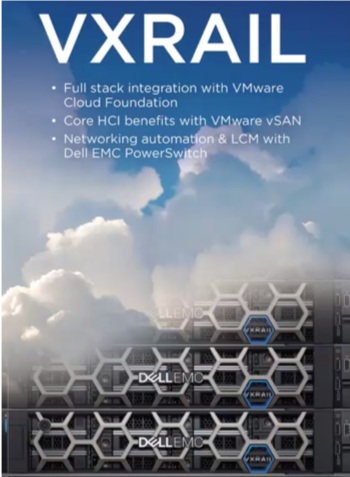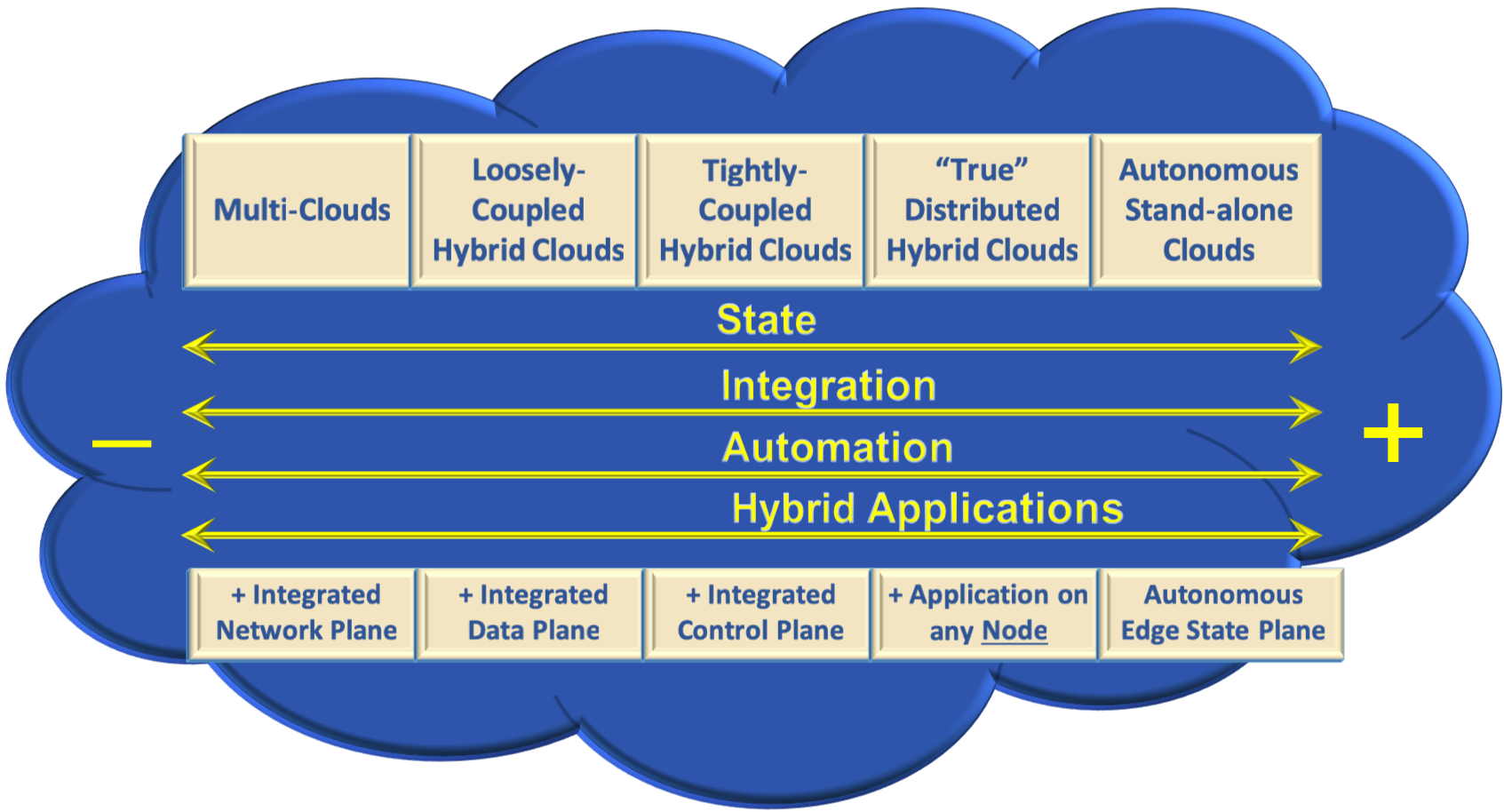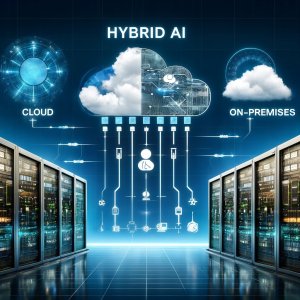Premise
Dell’s strategy relative to Alibaba, AWS, Microsoft Azure and other cloud providers is to go all-in on hybrid cloud. Wikibon believes this strategy is coherent and strong. Adoption of the Dell hybrid cloud architecture should be evaluated by enterprises for existing “Fat Middle”* workloads. In contrast, enterprise executives should evaluate future Dell initiatives and explore alternatives for the major Dell shortcomings. These include native cloud functionality, support for workloads with very demanding performance and recovery SLAs, and the Edge.
Dell and VMware will need to invest heavily and execute strongly for success. VMware in particular will need to move to a cloud-first continuous update model rather than its current traditional version model. Wikibon believes Dell will probably succeed and may become the major vendor for hybrid cloud, and is a good horse for enterprise executives to back.
Why Hybrid Cloud Architecture
The data-first hybrid cloud principle is to create clouds very close to the point of data creation. Then move or have code to this data, and process it. Then move a much smaller set of results to the next stage of processing, either local or remote. Developers should expect that the application workflows will be increasingly be dominated by real-time machine-to-machine interactions, which will put pressure on application latency.
A single monolithic cloud is simpler than a hybrid cloud. The economies of infrastructure scale are better. More software is available to process the data. However, the cost and elapsed time to move all data to a monolithic cloud is a killer. As a result, it reduces the options to extract value from the data.
In summary, in a data-first world, hybrid cloud and hybrid applications** creates many more business and technical options, and greater digital flexibility. This is because moving code to data is so much quicker and more functional than the traditional moving data to code.
Need to Know: Dell’s Hybrid Cloud Architecture
Dell Hybrid Cloud Hyper-converged Infrastructure (HCI)

Source: Dell 2019
VxRail is Dell’s primary “Hybrid Cloud Ready” HCI offering. VxRail is tightly bound with VMware. VxRail offers fully software defined HCI.
vSAN provides the storage software layer, often known as Server SAN. It aggregates storage devices to create a single storage pool shared across all hosts in a vSAN cluster. This simplifies storage configuration and virtual machine provisioning in a hybrid cloud.
VMware NSX & NSX Cloud provide virtual networking and networking security services across hybrid cloud nodes. This allows networking automation, and software supporting a hybrid cloud control plane***.
Dell Technologies Cloud Platform
VxRail is now full integrated with VMware Cloud Foundation (VCF), which provides the hybrid cloud control planes. Dell has also introduced a Dell Cloud Platform (previously known as Project Dimension, and now rebranded by a number of confusing names. Wikibon will refer to these as just the Dell Cloud Platform). This cloud runs on Dell’s own hardware, and provides the control plane for clusters of VxRail deployments.
This functionality allows Dell to execute most of the work of life-cycle maintenance of firmware and infrastructure software. As a result, enterprises can obtain a fundamental cloud benefit of a single throat to choke and a single hand to shake. These are significant advantages to enterprise customers, as this work in undifferentiated. Volume execution should give Dell the ability apply economies of scale, and improve the reliability and speed for application of security patches and functional improvements.
The strategic importance of this announcement is that it gives Dell the potential to move to a Cloud-first architecture and a continuous update model. Enterprises should ask for written confirmation of this strategy.
It also acts as a data aggregation point for all data derived from managing the on-premises hardware. In turn, should allow Dell to develop analytics that can automate operational problem solving. Wikibon assesses this as a major requirement, in particular because alerts have overwhelmed the ability of operators to process them without error and risk. Operator mistakes are a significant root cause of disasters. These are one of the biggest areas of exposure in managing operational systems. – dealing with the plethora of complex of area As a starting point,
Dell Data Software Defined Protection Services
Dell has announced a software defined data protection platform for hybrid cloud, branded as PowerProtect, This provides data protection, replication and reuse services either as software-only or as an appliance. The software-only can run in a number of clouds or on premises.
A SaaS-based service enables backup and recovery orchestration services across a hybrid cloud. VMware adds vRealize automation of policy-based backup and recovery.
Wikibon assesses the Dell data protection platform as a strong response to many other alternatives, and a break with the previous appliance-led Dell strategy. Choice of a data protection hybrid cloud plane or planes is an important strategic decision. Migration cost from existing software, processes and procedures is an important component of this choice. Wikibon observes that Dell has provided migration tools that should be assessed.
Must-cloud connectivity
Microsoft and Dell announced a far reaching partnership. VMware users have three main choices of cloud; AWS, IBM, & Microsoft Azure. Dell and Microsoft will deliver a fully native and certified VMware cloud infrastructure on Microsoft Azure. Additionally, joint Microsoft 365 and VMware Workspace ONE customers will be able to manage Office 365 across devices via cloud-based integration with Microsoft Intune and Azure Active Directory.
VMware will also extend the capabilities of Microsoft Windows Virtual Desktop leveraging VMware Horizon Cloud on Microsoft Azure.
A key additional value is that VMware customers can access Micrsoft Azure services, and in particular cloud-native development services. Azure VMware Solutions enable organizations to tap into Azure’s development and provisioning services, which include access to capabilities such as AI, Machine Learning, and IoT.
The Business Case for Hybrid Cloud
Wikibon assesses there are strong technical and business reasons for hybrid cloud for most enterprises. The technical (IT) reasons are:
- Roughly equivalent costs, when the cost of data movement is factored in;
- Greater flexibility to optimize the location of data and compute;
- Potential for far higher application functionality
The business reasons are:
- Avoidance of major cloud conversion and migration costs;
- Faster time-to-cloud;
- Improved cloud options.
- Business risk reduction and compliance.
Most enterprise will find both good technical and good business justifications for deploying hybrid cloud. For some enterprises a single cloud may be all they need at the moment. However, it would be wise to keep open multi-cloud and hybrid cloud options for future digital initiatives and partnerships.
Competitive Implications
- The Dell hybrid cloud architecture is a strong competitive response to AWS Outposts, Google Anthos, Microsoft Azure Stack, Oracle Cloud at Customer and other on-premises integrated solutions.
- Michael Dell tenaciously negotiated with VMware’s shareholders to enable Dell to recast VMware as a fully integrated member of the Dell Technologies portfolio of companies. This move highlights and underscores the synergies across all of Dell.
- VMware is the lynchpin of Dell’s hybrid cloud strategy, building on well established operational software deployed by 600,000 customers. The combined engineering teams are developing VMware and Dell technologies to make highly differentiated integrated products. This will make it more difficult for competition over time.
- It’s early days for hybrid cloud. Major integration work, data gathering, and development of hybrid services needs to be addressed over the next five years;
- Dell is getting an early foothold and is forging positive relationships with Alibaba, AWS, Google, and Microsoft.
- VMware is a clear favorite in the hybrid cloud race along with IBM Red Hat.
- This is a battle for the development and acceptance of services within the hybrid cloud planes, including the networking, data, control, data management, data protection planes and compliance planes;
- Wikibon expects that AWS will continue arguing a single cloud is simpler for the next few years. When necessary, Wikibon projects AWS will move aggressively and execute well to provide multi-cloud integrations for its customers.
- Overall, these announcements are great news for VMware customers. They have a choice of cloud platforms on AWS, IBM, and Microsoft Azure, and can combine these with on premises instances.
- Wikibon projects that most traditional on-site infrastructure vendors will not be able to provide the same levels of integration and analytics at a system level.
- The overall business case as discussed above will increase significantly in Dell’s favor over time.
Conclusions
Dell should be included on any shortlist as a potential strategic partner. Dell hybrid cloud architecture is an integrated combination of software and hardware, and is strategic for Dell. The VMware software offers good operational capabilities, and has sufficient volume to attract strong investment by Dell. Dell is the largest provider of enterprise infrastructure hardware, and will continue to offer different HCI solutions. The combination of software and hardware volumes put Dell in a position to compete strongly in the emerging hybrid cloud.
Dell and VMware will need to address a weakness in native cloud functionality. The Dell PaaS layer is weak. While Dell Pivotal is a good niche product, it is extremely unlikely to achieve volume acceptance as a PaaS layer. The partnership with Microsoft to enable access to Microsoft development tools on the Microsoft Azure cloud is a positive step, and should be assessed. Wikibon believes Dell will need to further address this with acquisitions and additional partnerships.
Dell also needs to introduce a marketplace to enable ISVs to integrate their applications into the Dell hybrid cloud architecture. AWS has a powerful marketplaceDell need to encourage hybrid applications**, and introduce functionality which will facilitate orchestration and automation for hybrid cloud environments.
Dell & VMware needs to bring in much lower costs at the Edge. The traditional Intel architecture is likely to be too costly and its software too inefficient for Edge volume applications.
Lastly, Dell will need to address specific applications with special needs they can’t provide. Dell would probably best advised to develop partnerships with leading SaaS vendors, and platforms such as IBM Mainframe and Oracle Cloud at Customer. In particular, low-latency network communications with protocol flexibility are an important multi-cloud networking capability that enterprise customers should demand.
Overall, Dell is well placed to thrive in a hybrid cloud world, and to significantly contribute to digital initiatives and innovation. Our view is that Dell Technologies is aggressively partnering with key cloud industry leaders (e.g. AWS, Microsoft, Google, IBM, Alibaba) and is leveraging volume and its VMware asset to attempt to dominate the multi-cloud wave
Action Item
Today’s multi-cloud has been a symptom of multi-vendor and shadow IT. Going forward, organizations must be more deliberate about formulating multi-cloud and hybrid cloud strategies that will facilitate digital innovation. In particular, data from any source or location should be managed as a corporate resource.
There will be a the need to balance demand for cloud agility, speed and scale with corporate edicts related to security, privacy, compliance, etc. This approach will facilitate the development of hybrid applications** that support digital innovation at scale.
Footnotes
* “Fat Middle” refers to the large envelope of enterprise applications that don’t put too much stress on the infrastructure. There are important applications outside this envelope that put stress in one or more areas, such as ultra-low data latency requirements, high security requirements, very high availability with very fast recovery requirements, ultra-high transaction rates, and ultra-low transmission latency. These important applications usually require specialized hardware and software platforms. Examples of these platforms include IBM Mainframes, Iguazio, Oracle Cloud at Customer, and many others.
**”Hybrid Applications” can run against data located in multiple nodes of hybrid cloud. The can enable the hybrid application to be spread across the hybrid cloud, achieve parallel execution when possible, and move just the results to other nodes for final consolidation. This minimizes elapsed time for the execution of complex applications accessing large amounts of data across multiple nodes in multiple locations.
***”Hybrid cloud control plane(s)” Wikibon published a Hybrid Cloud Taxonomy as shown in Figure 2 below. The VMware Hybrid clouds can be both Tightly-coupled Hybrid Clouds and “True” Distributed Hybrid Clouds. The VxRail Hybrid Cloud can use the Dell Cloud to enable management of the nodes across the VCF control plane. A full discussion can be found in the original research.

Source: © Wikibon 2019


